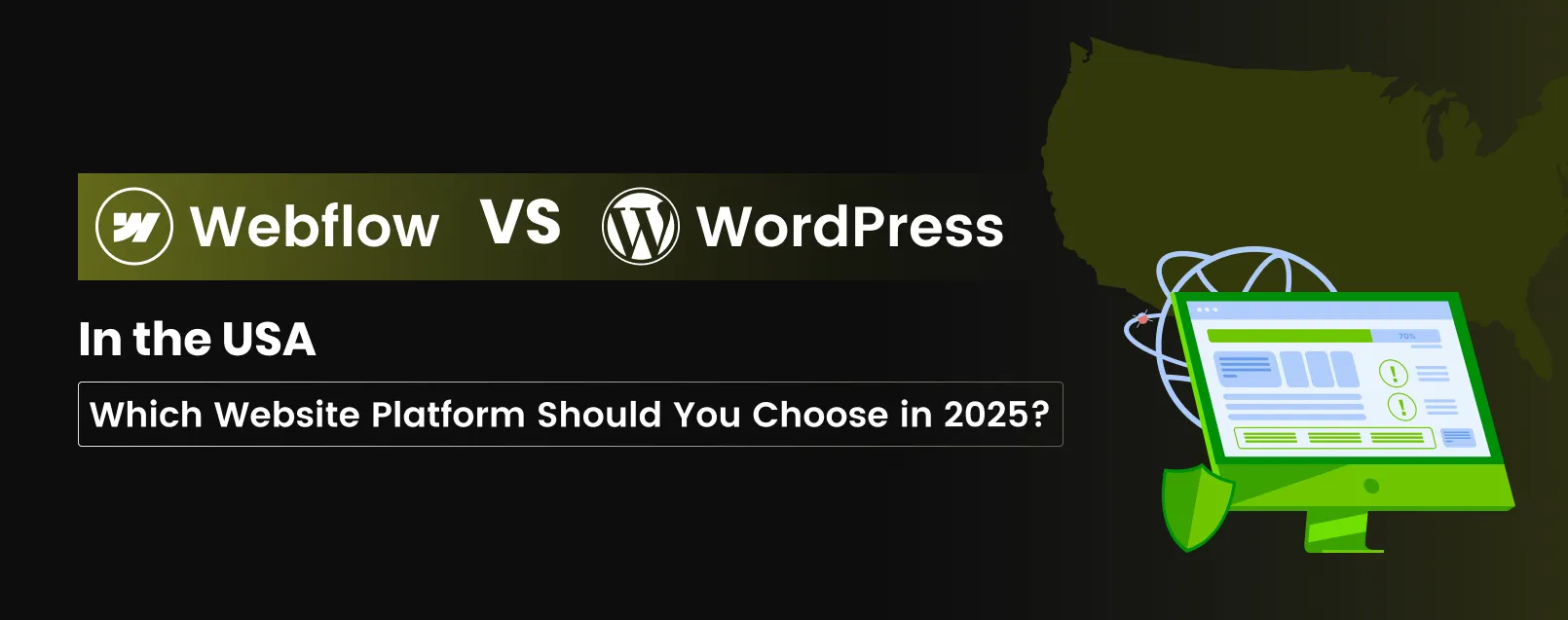

Webflow vs WordPress in the USA: Which Website Platform Should You Choose in 2025?

If you're building or redesigning your company’s website in 2025, chances are you’re comparing two major players: Webflow and WordPress. Both platforms are powerful in their own right—but which one aligns best with the needs of fast-moving U.S. startups, SaaS companies, agencies, and D2C brands?
In this article, we’ll give you a side-by-side breakdown of Webflow and WordPress tailored to the U.S. market, including performance, SEO, pricing, and real-world use cases.
Quick Overview: Webflow vs WordPress
Webflow: The Modern No-Code Platform
Webflow allows teams to visually build websites with pixel-level control—without writing code. Its USP is performance: clean code, minimal bloat, and hosted on fast, scalable infrastructure. The CMS supports structured content like blog posts, case studies, or product listings.
In the U.S., it’s increasingly adopted by:
- SaaS companies and YC-backed startups
- Marketing agencies and freelancers
- D2C and e-commerce founders seeking better UX
WordPress: The Customizable Giant
WordPress is the most widely-used CMS in the world—flexible, open-source, and highly customizable. But that flexibility comes with trade-offs: plugin reliance, security patches, and the need for hosting setup and developer oversight.
It continues to be used heavily in the U.S. for:
- Blog-heavy or content-first platforms
- Custom integrations via PHP
- Brands that want full backend control
Key Considerations for U.S.-Based Teams
1. Performance and Core Web Vitals
Google’s Page Experience signals now impact rankings in the U.S. more than ever. Site speed, interactivity, and visual stability matter.
- Webflow loads fast out of the box thanks to CDN-backed hosting and clean HTML/CSS.
- WordPress can match speed—but only with plugins like WP Rocket, performance themes like Astra, and CDN setup.
Verdict: Webflow requires less setup to meet performance benchmarks in U.S. search rankings.
2. SEO Optimization
- Webflow offers native control over meta titles, descriptions, canonical tags, schema, and sitemap submissions. It also supports automatic image compression and URL slug optimization.
- WordPress relies on tools like Yoast or RankMath for SEO features. These are powerful but plugin-reliant.
Verdict: Webflow is built SEO-ready. WordPress allows deeper control—but only if configured correctly.
3. Design Freedom & Brand Identity
- Webflow enables full visual customization—perfect for U.S. brands that demand elevated aesthetics. You can create interactions, transitions, and animations visually.
- WordPress is theme-based. Heavy customization requires frontend developers and often breaks with updates.
Verdict: For modern U.S. brands, Webflow offers unmatched design agility.
4. Security and Compliance (SOC2/GDPR)
- Webflow includes SSL, automatic backups, version control, and hosting on secure servers. Ideal for startups aiming for SOC2 compliance or security audits.
- WordPress security depends on the host and plugin maintenance. Vulnerabilities arise from outdated themes or poor plugin hygiene.
Verdict: Webflow is more secure for lean U.S. tech teams without a dedicated DevOps function.
5. Developer Support and Resources
In the U.S., both platforms have robust communities.
- WordPress developers are abundant but may be expensive.
- Webflow is gaining ground among designers, marketers, and low-code developers who want more autonomy.
Verdict: WordPress wins in legacy enterprise support. Webflow wins with agile teams and fast iteration.
Real-World Use Cases (from UnFoldMart’s Portfolio)
At UnFoldMart, we work with brands across the U.S. and globally—leveraging both Webflow and WordPress based on client goals.
Wishlink (Webflow)
For Wishlink, a fashion-tech brand, we built a responsive Webflow site optimized for influencer onboarding and seamless discovery. The result: better conversion rates, shorter dev cycles, and lightning-fast page loads.
Atmosly (Webflow)
Atmosly.com, a U.S.-based DevOps platform, needed a site that could evolve fast with product updates. Webflow’s CMS, combined with scroll animations and native SEO structure, delivered an agile and scalable marketing website.
SquareOps (WordPress)
For SquareOps, a performance marketing tech brand, we built on WordPress to accommodate long-form blogs and integrations with internal dashboards. It required more frequent updates but was ideal for structured editorial content.
Cost Comparison (U.S. Market)
Verdict: Webflow offers transparent monthly pricing. WordPress starts cheap but grows costlier with plugins and support needs.
CMS Flexibility
If your business needs a marketing site with flexible content sections - case studies, blogs, product showcases—Webflow’s CMS is intuitive for U.S. content teams.
For more complex content operations (multi-author blogs, gated content, forums), WordPress remains strong.
Verdict: Webflow is best for marketing-first CMS. WordPress is better for publishing-first websites.
Maintenance and Scalability
- Webflow removes friction: no plugin updates, no server issues, no downtime during scale.
- WordPress can scale with enterprise-grade hosts and performance plugins, but needs oversight.
Verdict: Webflow is ideal for lean U.S. startups with limited tech resources.
Which One Should You Choose?
In 2025, Webflow is quickly becoming the standard for modern U.S. brands that want full control over design, SEO, and performance - without the cost or complexity of traditional development.
Our Web Platform Services
UnFoldMart helps U.S.-based teams build digital experiences that convert. Whether you’re launching a Webflow site for a new product or maintaining a legacy WordPress platform, our team of strategists, designers, and developers has done it all.
- Built conversion-first Webflow sites for Wishlink and Atmosly
- Scaled high-traffic WordPress properties like SquareOps
- Integrated SEO, Webflow CMS, and design systems end-to-end
Need help choosing the right path?
Book a free strategy call and let’s map out your next site launch.
FAQs
Got Questions? We’ve Got Answers – Clear, Simple, and Straight to the Point
Yes. Migration is possible but requires planning to preserve SEO, content structure, and redirects. Agencies like UnFoldMart specialize in this process.
Many U.S. SaaS brands choose Webflow for speed, scalability, and modern design flexibility, while WordPress remains popular for large content libraries.
WordPress may start cheaper with hosting, but costs add up for plugins and maintenance. Webflow has transparent monthly pricing with hosting included.
Yes. Webflow’s clean code, built-in SEO tools, and fast hosting often give it an edge for Core Web Vitals and Google rankings in the U.S.
Webflow is ideal for design-focused, fast-scaling startups, while WordPress suits content-heavy businesses needing complex integrations.
Still have questions?
No question is too small—let’s talk
We don’t just execute—we create impact. Whether you need cutting-edge campaigns, high-performing strategies, or breakthrough brand growth, we’re the team to make it happen.
Let’s turn ideas into action and results into success.






.webp)